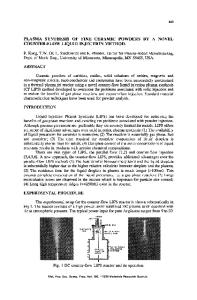Synthesis of ceramic oxide powders in a microwave plasma device
- PDF / 1,405,142 Bytes
- 7 Pages / 576 x 792 pts Page_size
- 66 Downloads / 405 Views
Kurt E. Sickafus Los Alamos National Laboratory, Los Alamos, New Mexico 87545 (Received 26 March 1993; accepted 26 June 1993)
Synthesizing oxide ceramic powders by application of a microwave plasma is a great advantage. There are two ways the microwave plasma can be used: The first is as a source of heat for the pyrolysis of solutions and the second is to excite gas reactions to obtain nanosized powders. Both applications are superior to standard methods. A microwave cavity well suited for these experiments and its operating characteristics are described. Using a microwave plasma as a source of heat for pyrolytic decomposition of nitrates in aqueous solutions leads to a fine-grained product with particle sizes from 100 to 1000 nm. Crystallite sizes in those particles are in most cases less than 10 nm. This is demonstrated with zirconia-based ceramics, such as ZrO 2 -3 mol% Y 2 O 3 -20 mol% A12O3. Depending on the conditions during pyrolysis, it is possible to obtain a product in which alumina is either dissolved in zirconia or the onset of the phase separation is observed. The energy efficiency of this process is better than 80%. If the reactants are gaseous, e.g., ZrCl4, it is possible to produce powders with mean particle sizes of about 4 nm. In the case of zirconia, these particles are monocrystalline with a cubic structure. This structure is not in equilibrium under the experimental conditions.
I. INTRODUCTION Pyrolytically prepared powders usually exhibit excellent homogeneity and small grain sizes. This is of importance, as it is nearly impossible to obtain perfect homogeneity when synthesizing complex powders using classical ceramic technologies, such as blending or milling. In the case of chemical precipitation it is difficult to obtain homogeneous powders, as the different constituents usually precipitate at different pH values. Pyrolytic processes, performed in electrically heated systems, usually have low energy efficiency.1'2 Energy efficiency can be improved by using a flame as a source of heat; however, this process is constrained by chemistry and safety of the flame.3'4 These problems can be minimized if a plasma is used as a source of thermal energy.5'6 Certainly, the energy efficiency of a flame process cannot be reached, as all processes using electrical energy are impaired by the second law of thermodynamics. Direct coupling of microwaves to a mist of a salt solution avoiding a plasma does not lead to a dried and completely reacted product. This is because the coupling of microwaves with frequencies up to 2.45 GHz to the small droplets is not sufficient.78 Other interesting applications of a microwave plasma are gas reactions, where kinetic or thermodynamic inhibitions can be overcome. These obstacles are overcome by the interaction of gas species of the starting material with charged particles like electrons, 2978
http://journals.cambridge.org
J. Mater. Res., Vol. 8, No. 11, Nov 1993
Downloaded: 24 Mar 2015
ions, or radicals. This opens the door to new routes for synthesis of nanophased ce
Data Loading...











